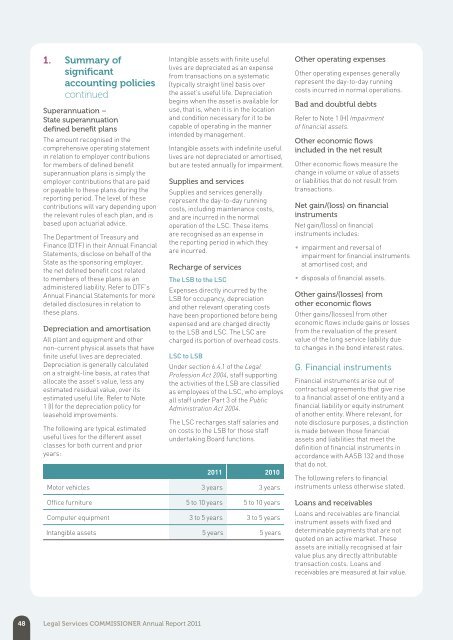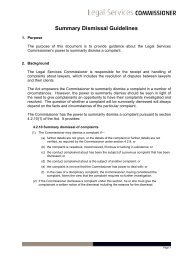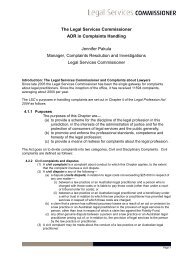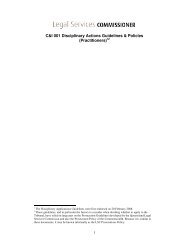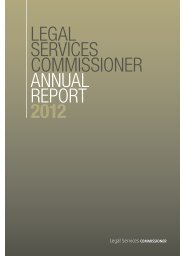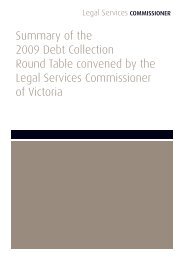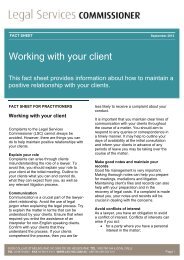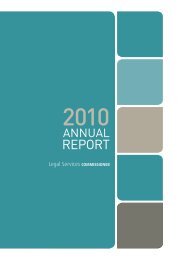Annual Report 2011 - Legal Services Commissioner
Annual Report 2011 - Legal Services Commissioner
Annual Report 2011 - Legal Services Commissioner
Create successful ePaper yourself
Turn your PDF publications into a flip-book with our unique Google optimized e-Paper software.
1. Summary of<br />
significant<br />
accounting policies<br />
continued<br />
Superannuation –<br />
State superannuation<br />
defined benefit plans<br />
The amount recognised in the<br />
comprehensive operating statement<br />
in relation to employer contributions<br />
for members of defined benefit<br />
superannuation plans is simply the<br />
employer contributions that are paid<br />
or payable to these plans during the<br />
reporting period. The level of these<br />
contributions will vary depending upon<br />
the relevant rules of each plan, and is<br />
based upon actuarial advice.<br />
The Department of Treasury and<br />
Finance (DTF) in their <strong>Annual</strong> Financial<br />
Statements, disclose on behalf of the<br />
State as the sponsoring employer,<br />
the net defined benefit cost related<br />
to members of these plans as an<br />
administered liability. Refer to DTF’s<br />
<strong>Annual</strong> Financial Statements for more<br />
detailed disclosures in relation to<br />
these plans.<br />
Depreciation and amortisation<br />
All plant and equipment and other<br />
non‐current physical assets that have<br />
finite useful lives are depreciated.<br />
Depreciation is generally calculated<br />
on a straight‐line basis, at rates that<br />
allocate the asset’s value, less any<br />
estimated residual value, over its<br />
estimated useful life. Refer to Note<br />
1 (I) for the depreciation policy for<br />
leasehold improvements.<br />
The following are typical estimated<br />
useful lives for the different asset<br />
classes for both current and prior<br />
years:<br />
Intangible assets with finite useful<br />
lives are depreciated as an expense<br />
from transactions on a systematic<br />
(typically straight line) basis over<br />
the asset’s useful life. Depreciation<br />
begins when the asset is available for<br />
use, that is, when it is in the location<br />
and condition necessary for it to be<br />
capable of operating in the manner<br />
intended by management.<br />
Intangible assets with indefinite useful<br />
lives are not depreciated or amortised,<br />
but are tested annually for impairment.<br />
Supplies and services<br />
Supplies and services generally<br />
represent the day‐to‐day running<br />
costs, including maintenance costs,<br />
and are incurred in the normal<br />
operation of the LSC. These items<br />
are recognised as an expense in<br />
the reporting period in which they<br />
are incurred.<br />
Recharge of services<br />
The LSB to the LSC<br />
Expenses directly incurred by the<br />
LSB for occupancy, depreciation<br />
and other relevant operating costs<br />
have been proportioned before being<br />
expensed and are charged directly<br />
to the LSB and LSC. The LSC are<br />
charged its portion of overhead costs.<br />
LSC to LSB<br />
Under section 6.4.1 of the <strong>Legal</strong><br />
Profession Act 2004, staff supporting<br />
the activities of the LSB are classified<br />
as employees of the LSC, who employs<br />
all staff under Part 3 of the Public<br />
Administration Act 2004.<br />
The LSC recharges staff salaries and<br />
on costs to the LSB for those staff<br />
undertaking Board functions.<br />
<strong>2011</strong> 2010<br />
Motor vehicles 3 years 3 years<br />
Office furniture 5 to 10 years 5 to 10 years<br />
Computer equipment 3 to 5 years 3 to 5 years<br />
Intangible assets 5 years 5 years<br />
Other operating expenses<br />
Other operating expenses generally<br />
represent the day‐to‐day running<br />
costs incurred in normal operations.<br />
Bad and doubtful debts<br />
Refer to Note 1 (H) Impairment<br />
of financial assets.<br />
Other economic flows<br />
included in the net result<br />
Other economic flows measure the<br />
change in volume or value of assets<br />
or liabilities that do not result from<br />
transactions.<br />
Net gain/(loss) on financial<br />
instruments<br />
Net gain/(loss) on financial<br />
instruments includes:<br />
• impairment and reversal of<br />
impairment for financial instruments<br />
at amortised cost; and<br />
• disposals of financial assets.<br />
Other gains/(losses) from<br />
other economic flows<br />
Other gains/(losses) from other<br />
economic flows include gains or losses<br />
from the revaluation of the present<br />
value of the long service liability due<br />
to changes in the bond interest rates.<br />
G. Financial instruments<br />
Financial instruments arise out of<br />
contractual agreements that give rise<br />
to a financial asset of one entity and a<br />
financial liability or equity instrument<br />
of another entity. Where relevant, for<br />
note disclosure purposes, a distinction<br />
is made between those financial<br />
assets and liabilities that meet the<br />
definition of financial instruments in<br />
accordance with AASB 132 and those<br />
that do not.<br />
The following refers to financial<br />
instruments unless otherwise stated.<br />
Loans and receivables<br />
Loans and receivables are financial<br />
instrument assets with fixed and<br />
determinable payments that are not<br />
quoted on an active market. These<br />
assets are initially recognised at fair<br />
value plus any directly attributable<br />
transaction costs. Loans and<br />
receivables are measured at fair value.<br />
48 <strong>Legal</strong> <strong>Services</strong> COMMISSIONER <strong>Annual</strong> <strong>Report</strong> <strong>2011</strong>


